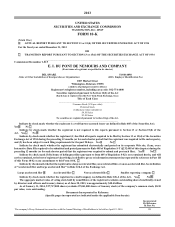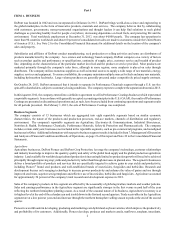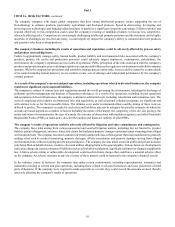DuPont 2013 Annual Report Download - page 10
Download and view the complete annual report
Please find page 10 of the 2013 DuPont annual report below. You can navigate through the pages in the report by either clicking on the pages listed below, or by using the keyword search tool below to find specific information within the annual report.Part I
ITEM 1A. RISK FACTORS, continued
9
by hackers; viruses; breaches due to employee error or actions; or other disruptions could result in misuse of the company's assets,
business disruptions, loss of property including trade secrets and confidential business information, legal claims or proceedings,
reporting errors, processing inefficiencies, negative media attention, loss of sales and interference with regulatory compliance.
Like most major corporations, DuPont is the target of industrial espionage, including cyber-attacks, from time to time. DuPont
has determined that these attacks have resulted, and could result in the future, in unauthorized parties gaining access to at least
certain confidential business information. However, to date, the company has not experienced any material financial impact,
changes in the competitive environment or business operations that it attributes to these attacks. Although management does not
believe that the company has experienced any material losses to date related to security breaches, including cybersecurity incidents,
there can be no assurance that it will not suffer such losses in the future. The company actively manages the risks within its control
that could lead to business disruptions and security breaches. As these threats continue to evolve, particularly around cybersecurity,
the company may be required to expend significant resources to enhance its control environment, processes, practices and other
protective measures. Despite these efforts, such events could materially adversely affect the company's business, financial condition
or results of operations.
Inability to protect and enforce the company's intellectual property rights could adversely affect the company's financial
results.
Intellectual property rights, including patents, plant variety protection, trade secrets, confidential information, trademarks,
tradenames and other forms of trade dress, are important to the company's business. The company endeavors to protect its intellectual
property rights in jurisdictions in which its products are produced or used and in jurisdictions into which its products are imported.
However, the company may be unable to obtain protection for its intellectual property in key jurisdictions. The company has
designed and implemented internal controls to restrict access to and distribution of its intellectual property. Despite these
precautions, the company's intellectual property is vulnerable to unauthorized access through employee error or actions, theft and
cybersecurity incidents, and other security breaches. When unauthorized access and use or counterfeit products are discovered,
the company reports such situations to governmental authorities for investigation, as appropriate, and takes measures to mitigate
any potential impact.
Failure to effectively manage acquisitions, divestitures, alliances and other portfolio actions could adversely impact our
future results.
From time to time, the company evaluates acquisition candidates that may strategically fit its business and/or growth objectives.
If DuPont is unable to successfully integrate and develop acquired businesses, the company could fail to achieve anticipated
synergies and cost savings, including any expected increases in revenues and operating results, which could materially and adversely
affect the company’s financial results. DuPont continually reviews its diverse portfolio of assets for contributions to the company’s
objectives and alignment with its growth strategy. However, the company may not be successful in separating underperforming
or non-strategic assets and gains or losses on the divestiture of, or lost operating income from, such assets may affect the company’s
earnings. Moreover, DuPont might incur asset impairment charges related to acquisitions or divestitures that reduce its earnings.
In October 2013, DuPont announced its intention to separate its Performance Chemicals segment through a U.S. tax-free spin-off
to shareholders. The proposed spin-off is subject to various conditions, complex in nature and may be affected by unanticipated
developments or changes in market conditions. Completion of the spin-off will be contingent upon customary closing conditions,
including receipt of regulatory approvals.
Market acceptance, government policies, rules or regulations and competition could affect the company's ability to generate
sales from products based on biotechnology.
The company is using biotechnology to create and improve products, particularly in its Agriculture and Industrial Biosciences
segments. These products enable cost and process benefits, better product performance and improve environmental outcomes to
a broad range of products and processes such as seeds, animal nutrition, detergents, food manufacturing, ethanol production and
industrial applications. The company's ability to generate sales from such products could be impacted by market acceptance as
well as governmental policies, laws and regulations that affect the development, manufacture and distribution of products, including
the testing and planting of seeds containing biotechnology traits and the import of commodity grain grown from those seeds. The
regulatory environment is lengthy and complex with requirements that can vary by industry and by country. The regulatory
environment may be impacted by the activities of non-governmental organizations and special interest groups and stakeholder
reaction to actual or perceived impacts of new technology on safety, health and the environment. Obtaining and maintaining
regulatory approvals requires submitting a significant amount of information and data, which may require participation from
technology providers. The ability to satisfy the requirements of regulatory agencies is essential to be able to continue to sell existing
products or commercialize new products containing biotechnology traits.























